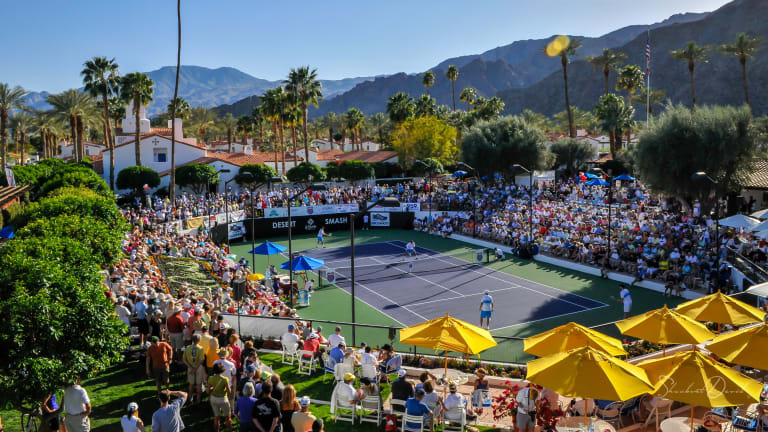Tennis has been transformed over the last five decades by TV, money, technology, equipment, fashion and politics. But through all of that, the players have remained at the heart of the game. As part of our golden anniversary celebration of the Open era, Tennis.com presents its list of 50 best players—the Top 25 men and the Top 25 women—of the last 50 years. You'll be able to view the entire list in the March/April issue of TENNIS Magazine.
(Note: Only singles results were considered; any player who won a major title during the Open era had his or her entire career evaluated; all statistics are through the 2018 Australian Open.)
Years played: 1973-2006
*Titles: 167
Major titles: 18*
When Martina Navratilova emerged from communist Czechoslovakia to join the WTA tour as a 16-year-old in 1973, she didn’t appear to be a future No. 1 in training. Suddenly exposed to Western consumer culture, she took a liking to one of its most glorious products: fast food. Looking back, it probably shouldn’t have been a surprise that she lost 14 of her first 16 matches to her future rival for the ages, Chris Evert.
Yet everyone recognized that Navratilova had talent. The best Czech player of the time, Jan Kodes, was an early champion of hers, and Rod Laver singled his fellow lefty out at a junior clinic. Her speed, spin serve, hand skills, and court sense were obvious. Few in the sport have ever moved like Martina, or had such a knack for using her athleticism to attack. Even as she was learning to fend off the temptations of Burger King, she reached the finals of the Australian Open and French Open as an 18-year-old in 1975.
It turned out that the young Navratilova wasn’t just talented; she was also brave. That same year, after losing in the semifinals at the US Open, she left her family and country and everything she knew to defect to the United States. Now on her own, she went through another adjustment period. By the summer of 1978, Evert had increased her lead in their head to head to 21-4. It seemed that the even-keel American would always be waiting when the volatile Czech’s up-and-down game took another turn for the worse.
But in one month-long swoop across British grass in ’78, Navratilova made good on her gifts and turned a lop-sided matchup with Evert into a rivalry. She won their final at Eastbourne, and then, in a surprise, came back from a set down to beat her in the Wimbledon final for her first major title. The following year, Navratilova went on her own four-match win streak against Evert.
By the spring of 1981, though, Evert appeared to have weathered the storm. Navratilova plunged again, hitting bottom in Amelia Island, where she lost to Evert 6-0, 6-0. During that event, though, a flash of blond hair in the crowd caught her eye. It belonged to Nancy Lieberman, the world’s best women’s basketball player. The two would soon form the core of the formidable new Team Navratilova and change how tennis players trained.
That same year, Navratilova showed her bravery again. She came out as gay around the same time that she became a U.S. citizen. The standing ovation she received after her heartbreaking loss in the ’81 US Open final made her feel welcome in her new home as she never had before. Martina was about to have herself a decade.
Training harder, eating better, thinking more strategically, and attacking more ruthlessly, Navratilova would win nine of the next 10 majors, including a record six in a row. She would win six straight Wimbledons, 13 straight meetings with Evert, and go 86-1 in 1983. She would take over and keep the No. 1 ranking for 156 straight weeks and finish five consecutive seasons in the top spot. From 1982 to 1990, she would go 626-36. She would finish with 1,442 match wins and 167 titles, both Open era records for either tour.
“Martina revolutionized the game with her superb athleticism and aggressiveness,” said Evert, who would end up trailing her rival, 43-37, in their head to head. “She brought athleticism to a whole new level with her training techniques.”
With each step Navratilova took to find and remake herself as a person—defecting, becoming American, coming out as gay, committing to success—she also found and remade herself as a player. If Evert was the most popular player of her era, and King the most politically significant, Martina was its pioneer of individual fulfillment. The journey is what matters, they say, and no player traveled farther in the course of her career than Navratilova.
Defining Moment: Navratilova put her hands to her eyes to hide the tears; she couldn’t talk anymore. So the US Open crowd made noise instead. They stood and cheered, and didn’t stop. It was moments after the 1981 final, and they had just watched their new countrywoman lose in a crushing third-set tiebreaker. Navratilova wouldn’t lose many more. Finally feeling at home in her adopted country, she would ride those ovations to a decade of unprecedented dominance.
Watch: Martina Navratilova's nine championship-winning points at Wimbledon
